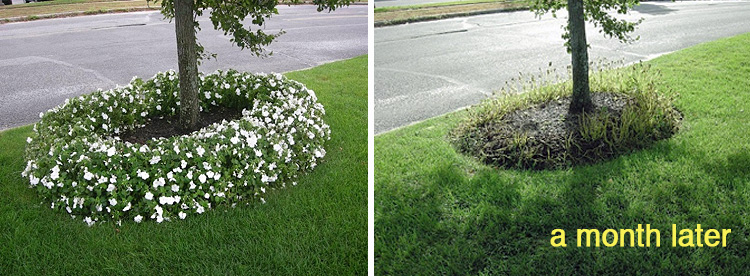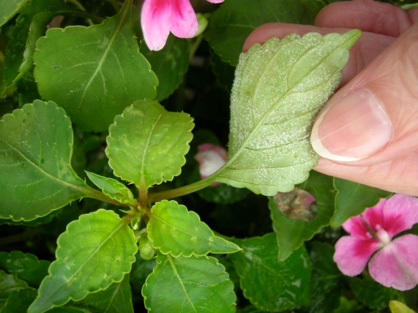Hope for Impatiens
This year Grandma couldn’t find impatiens (Impatiens walleriana) to plant in her flower beds. She’s always planted impatiens! But lately, impatiens have been sickened by downy mildew, caused by Plasmopara obducens. This plant disease has received attention the past few years because it decimates the most popular varieties of this annual garden plant. What you probably haven’t heard yet is the story of how impatiens, through sex, sheer luck, and the attention of one man, rose to the pinnacle of popularity only to be suddenly destroyed, all thanks to an unassuming downy mildew that has been lurking close to our back yards.

The story begins on shady river banks of east Africa, where cultivated impatiens have wild relatives. Compared to their domesticated descendants, wild impatiens are small, spindly, and have fewer flowers. They are unique in the way they disperse their seeds, using spring-loaded seed pods triggered by the slightest touch. Almost a century ago, impatiens were introduced as ornamentals to South and Central America, where their seed flinging habit allowed them to escape gardens and become naturalized.
It was these rogue impatiens, growing on a shaded Costa Rican roadside, that captured the attention of one Mr. Claude Hope. It’s an understatement to say Hope had a green thumb. A Texan by birth, he was a brilliant horticulturist who worked for the US government during World War II, researching plants in Central America. Much later he recalled in an interview that he’d first noticed cheerful impatiens on his walk to work during those years. Something about that plant, hardly more than a weed, inspired him. He recognized impatiens’ potential to become a popular garden plant. After the war, he put down roots in Costa Rica, developed a successful seed company, and began breeding impatiens, shaping them into the popular plants we know today.
 Plant breeding is a discipline at the intersection of gardening and genetics. Every vegetable on a grocery shelf, and every packet of seeds is a product of this process. It’s a sexy science, beginning when two plants are intentionally crossed. Their best offspring are selected for favorable traits by breeders and interbred over multiple generations, which might take years or decades. Once ideal plants are produced, they are usually only crossbred with each other, or clonally propagated with cuttings. Maintained this way, plants keep producing offspring with the desired physical traits. The impatiens varieties Claude Hope bred had more and longer-lasting blooms, in a range of bright colors. They were shade-tolerant and perfectly suited for North America’s gardening appetite.
Plant breeding is a discipline at the intersection of gardening and genetics. Every vegetable on a grocery shelf, and every packet of seeds is a product of this process. It’s a sexy science, beginning when two plants are intentionally crossed. Their best offspring are selected for favorable traits by breeders and interbred over multiple generations, which might take years or decades. Once ideal plants are produced, they are usually only crossbred with each other, or clonally propagated with cuttings. Maintained this way, plants keep producing offspring with the desired physical traits. The impatiens varieties Claude Hope bred had more and longer-lasting blooms, in a range of bright colors. They were shade-tolerant and perfectly suited for North America’s gardening appetite.
Most impatiens planted today owe their existence to the Father of impatiens’ six year-long breeding effort. For decades impatiens have been a garden staple, but recently this plant breeding success story took a dark twist. Hope considered himself extremely lucky for the relatively short time it took to create what became the most popular annual plant in America. But the same gardens, window boxes, and parks that he helped transform face a serious threat today. Mr. Hope died in 2000, and did not live long enough to witness their devastation by downy mildew.
Impatiens downy mildew is caused by Plasmopara obducens, which is not a fungus but an oomycete, a group better known as water molds. They resemble fungi to the naked eye, but their closest evolutionary relatives are diatoms and brown algae. Other oomycetes are also plant pathogens, and some cause sweeping epidemics and crop losses. One infamous example, Phytophthora infestans, caused Ireland’s Great Potato Famine in the 1840s and remains an important disease of potatoes and tomatoes today.
Impatiens downy mildew infects a range of impatiens varieties, but most of the time infections are not fatal. It’s just bad luck that it is truly devastating when it infects the most popular kinds of impatiens– hybrids developed by Mr. Hope from Impatiens walleriana. When these plants are infected they go from mild symptoms, with fuzzy white mildew on the undersides of leaves, to complete defoliation in the blink of an eye. Symptoms are less dramatic on other impatiens varieties– maybe only a little yellowing of leaves and stunted growth.
Here’s a time lapse of impatiens being killed by downy mildew.
Downy mildew sprouts on the underside of leaves as a fuzzy grey carpet, making millions of spores that are spread by rain and wind to other susceptible plants. When a spore lands, it can infect by growing directly into a leaf, or by producing swimming spores (zoospores). Zoospores swim across plant surfaces in thin layers of dew or rain, initiating multiple points of infection. A third kind of tough, thick-walled spore (the oospore) can endure in soil, perhaps for years, waiting for a susceptible plant to infect.
Unlike some pathogens that have been introduced and cause problems in a new environment, impatiens downy mildew is native to North America. It’s been documented here since the 19th century infecting pale jewelweeds and spotted touch-me-nots, native relatives of Impatiens walleriana. On these native hosts, symptoms are mild, sometimes little more than purple leaf spots. We have evidence of downy mildew infecting wild impatiens going back at least a hundred years. Impatiens have been popular for over thirty years, so why has this downy mildew become a problem in nurseries and gardens only in the past several years?
The factors behind the epidemic are under study by plant pathologists, while plant breeders search for disease-resistant varieties. We don’t know for sure, but we can guess that a random genetic change gave one lucky spore of our native downy mildew a new ability to kill Impatiens walleriana. The lucky descendents of this lucky spore found themselves surrounded by genetically similar, and thus similarly vulnerable Hope hybrids. This new downy mildew variant took off like wild fire. This is evolution in action. Luckily, not all impatiens varieties are vulnerable to downy mildew. For now Grandma can switch to New Guinea impatiens, or one of a handful of new, resistant impatiens varieties.
- First Report of Downy Mildew in Kentucky
- Remembering Claude Hope. New York Times, August 2000.
- Michael Pollan on Claude Hope: The Lives they Lived.
- An interview with Claude Hope, the Father of Impatiens. February 1998. Youtube.
- Information about impatiens downy mildew from Cornell Cooperative Extension of Suffolk Co..
- Laura Drotleff. Impatiens are not down and out. Greenhouse Grower, August 24, 2012. [Resistant alternatives]
Images courtesy Margery Daughtrey. Thanks, Margie!
Comments Off on Hope for Impatiens

